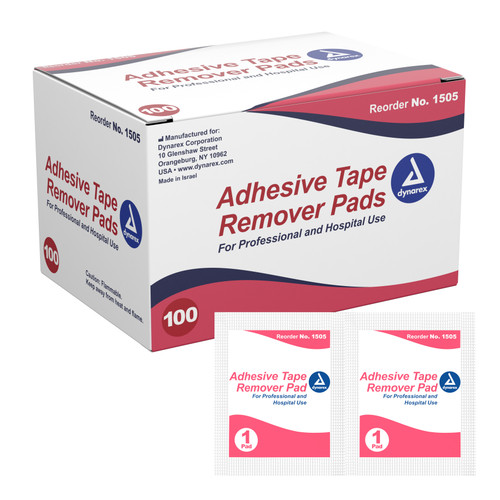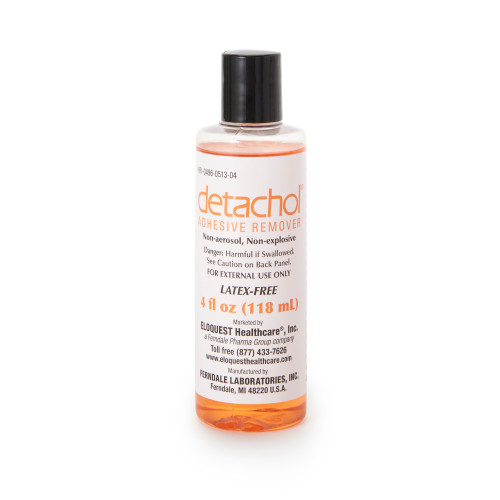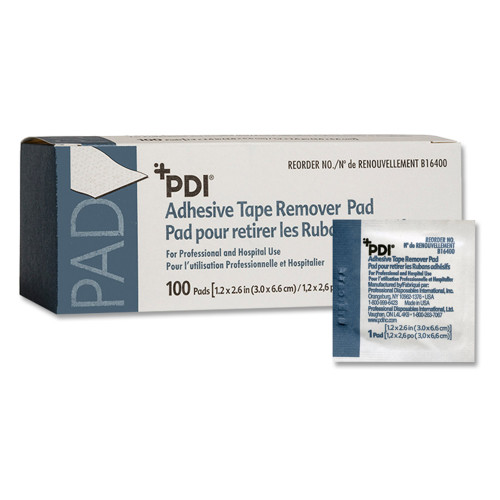-

Esenta Sting Free
Esenta Sting Free, Adhesive Remover Spray, Silicone-Based, 50 mL
Esenta Remover quickly and easily releases adhesives associated with the care of colostomies, ileostomies and urostomies. It also removes adhesive residue left by appliances, transdermal patches and wound care items. Pain is reduced, residue is...
As low as $28.86 -

Hollister
Adapt Adhesive Remover Spray
Hollister's Adapt medical adhesive remover spray is silicone-based with an alcohol-free formulation to deliver an efficient solution for skin barrier removal. There is no sting caused by alcohol and contains no CFCs. These medical supplies are not made...
$17.60 -

Dynarex
Dynarex Adhesive Remover, Non-Rensitizing, Non-Irritating
Aids in the removal of adhesive tapes and its residue.Reduces discomfort and leaves skin free of tape residue Non-irritating 100 pads per box
As low as $15.62 -

Detachol
Detachol Adhesive Remover for Tape, Non-Aerosol, Non-Explosive
Detachol is a non-irritating adhesive remover used to aid in the removal of dressings, tapes and most sticky residue from the skin and other surfaces.Non-aerosol Non-explosive
As low as $24.07 -

Smith & Nephew
Remove Universal Adhesive Remover, Cleans and Moisturizes Skin
Indicated for: the removal of adhesive devices and the removal of adhesive residue from skin.Aloe moisturizes and conditions skin without greasiness Gently cleans hydrocolloid, acrylic and rubber-based adhesive residues from skin without irritation,...
As low as $18.62 -

Smith & Nephew
UniSolve Adhesive Remover, Non-Sensitizing, Non-Irritating
Thoroughly dissolve dressing, tape and appliance adhesives using these Uni-Solve adhesive remover wipes, which are formulated with aloe to help reduce adhesive trauma to the skin. The wipes are ideal for removing ostomy faceplate adhesive bandages, plus...
As low as $22.43 -

Safe n Simple
Safe n Simple Peri-Stoma Cleanser & Adhesive Remover, 5 in x 7 in
Safe n Simple's adhesive removers are alcohol free and do not sting. These wipes are very gentle on the skin and a designed for easily irritated skin. The formula is a no-rinse design, so water is not needed to remove adhesive. Safe n Simple's adhesive...
As low as $16.81 -

PDI
PDI Adhesive Tape Remover Pad for Skin, 1 1/5 in x 2 3/5 in
Designed to reduce patient discomfort with the removal of adhesive tape from skin.Effectively softens and removes tape and residue from intact skin Reduces patient discomfort Contains C11-12 Isoparaffin, isopropyl alcohol, petroleum naphtha, isopropyl...
As low as $14.25 -

McKesson
McKesson Adhesive Remover Wipes, Alcohol-Based, 2 4/10 in x 2 4/10 in
Adhesive remover wipes, individually packaged, help to remove adhesive tape, adhesive residue and pouches from skin. 2.4 x 2.4 inches (6.1 x 6.1 centimeters)Helps to remove adhesive tape, adhesive residue and pouches from skin Cleanses skin and removes...
As low as $9.98
Adhesive Removers

Adhesive Removers
Many common bandages use adhesive to ensure they stay in place on the skin. When removing the bandage, the adhesive also needs to be removed, but this can be tricky.
An adhesive that is too strong can compromise the integrity of the skin around the wound, as can removing a bandage or tape too quickly. The use of adhesive remover prevents this additional injury and increases comfort when removing a bandage.
What Are Adhesive Removers?
Adhesive removers use mild chemicals that loosen and break down adhesives previously applied to the skin. Essentially, they dissolve the adhesive, and unlike some other home-remedy solutions, medical-grade adhesive removers are generally sterile and will also clean the affected area.
Ingredients in Medical Grade Adhesive Removers
Generally, medical-grade adhesive wipes contain paraffin. The paraffin helps ease the harshness of the isopropyl alcohol, another common ingredient in adhesive removers, that works to break down the adhesive and sterilize the area.
Detachol is a practical choice for someone sensitive to the harshness of isopropyl alcohol and other chemicals like acetone. It is a specially formulated adhesive remover containing specially developed paraffin hydrocarbon and is non-aerosol. It has no harsh chemicals, making it easy on the skin and easier for most patients to handle.
In What Applications Are Medical Grade Adhesive Removers Used?
You can remove bandages held on with medical tape, like around a surgical incision, and adhesive bandages using medical-grade adhesive remover pads. Not using an adhesive remover can cause pain and discomfort and unwanted tearing, further compromising the skin around the wound and even the unwanted (and painful) removal of hair around the affected area.
While often used in doctor’s offices and by wound care professionals, many people will find adhesive removers valuable additions to their medicine cabinets and first aid kits.
How Are Adhesive Removers Packaged?
They conveniently come in pre-soaked disposable pads or wipes. This keeps each pad sterile, and they are disposable. However, adhesive removers also come in bottles of liquid or sprays. You apply them using a cotton ball or a sterile gauze pad that can be rewetted and reused until all the adhesive is gone and the bandage is completely off.
How Do I Apply Medical Grade Adhesive Removers?
When removing a bandage already attached to the skin, pry up a small corner and apply adhesive remover as you go. You can do this using wipes, or in the case of liquid, apply a small amount of the remover to either sterile gauze or a sterile cotton ball or swab, and then gently to the area where the adhesive contacts the skin.
Always follow the manufacturer's directions of the specific medical-grade adhesive remover you are using.
If reapplying a bandage, ensure you remove all adhesive from the last bandage and confirm the area is clean and dry. Otherwise, what's left of the adhesive remover may prevent the new bandage from sticking to the skin and holding it in place.
You should not use these products if you have had allergies to adhesive removers or their ingredients. Discontinue use if any redness, rash, hives, or swelling occurs at the application site, and consult a medical professional. If you cannot safely remove the bandage or adhesive, skin tearing or pain results, consult a medical professional before proceeding further.
Many common bandages use adhesive to ensure they stay in place on the skin. When removing the bandage, the adhesive also needs to be removed, but this can be tricky.
An adhesive that is too strong can compromise the integrity of the skin around the wound, as can removing a bandage or tape too quickly. The use of adhesive remover prevents this additional injury and increases comfort when removing a bandage.
What Are Adhesive Removers?
Adhesive removers use mild chemicals that loosen and break down adhesives previously applied to the skin. Essentially, they dissolve the adhesive, and unlike some other home-remedy solutions, medical-grade adhesive removers are generally sterile and will also clean the affected area.
Ingredients in Medical Grade Adhesive Removers
Generally, medical-grade adhesive wipes contain paraffin. The paraffin helps ease the harshness of the isopropyl alcohol, another common ingredient in adhesive removers, that works to break down the adhesive and sterilize the area.
Detachol is a practical choice for someone sensitive to the harshness of isopropyl alcohol and other chemicals like acetone. It is a specially formulated adhesive remover containing specially developed paraffin hydrocarbon and is non-aerosol. It has no harsh chemicals, making it easy on the skin and easier for most patients to handle.
In What Applications Are Medical Grade Adhesive Removers Used?
You can remove bandages held on with medical tape, like around a surgical incision, and adhesive bandages using medical-grade adhesive remover pads. Not using an adhesive remover can cause pain and discomfort and unwanted tearing, further compromising the skin around the wound and even the unwanted (and painful) removal of hair around the affected area.
While often used in doctor’s offices and by wound care professionals, many people will find adhesive removers valuable additions to their medicine cabinets and first aid kits.
How Are Adhesive Removers Packaged?
They conveniently come in pre-soaked disposable pads or wipes. This keeps each pad sterile, and they are disposable. However, adhesive removers also come in bottles of liquid or sprays. You apply them using a cotton ball or a sterile gauze pad that can be rewetted and reused until all the adhesive is gone and the bandage is completely off.
How Do I Apply Medical Grade Adhesive Removers?
When removing a bandage already attached to the skin, pry up a small corner and apply adhesive remover as you go. You can do this using wipes, or in the case of liquid, apply a small amount of the remover to either sterile gauze or a sterile cotton ball or swab, and then gently to the area where the adhesive contacts the skin.
Always follow the manufacturer's directions of the specific medical-grade adhesive remover you are using.
If reapplying a bandage, ensure you remove all adhesive from the last bandage and confirm the area is clean and dry. Otherwise, what's left of the adhesive remover may prevent the new bandage from sticking to the skin and holding it in place.
You should not use these products if you have had allergies to adhesive removers or their ingredients. Discontinue use if any redness, rash, hives, or swelling occurs at the application site, and consult a medical professional. If you cannot safely remove the bandage or adhesive, skin tearing or pain results, consult a medical professional before proceeding further.
